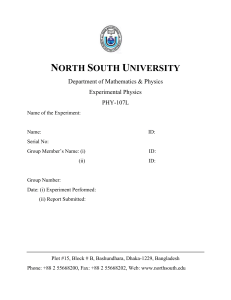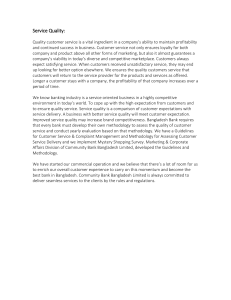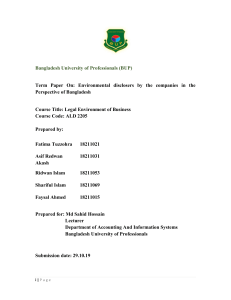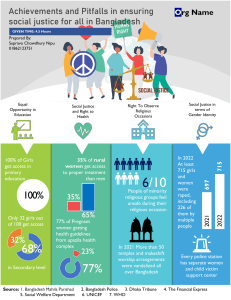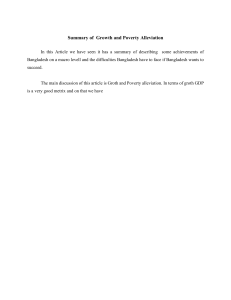Bangladesh Garment Industry: Environmental & Legal Issues
advertisement
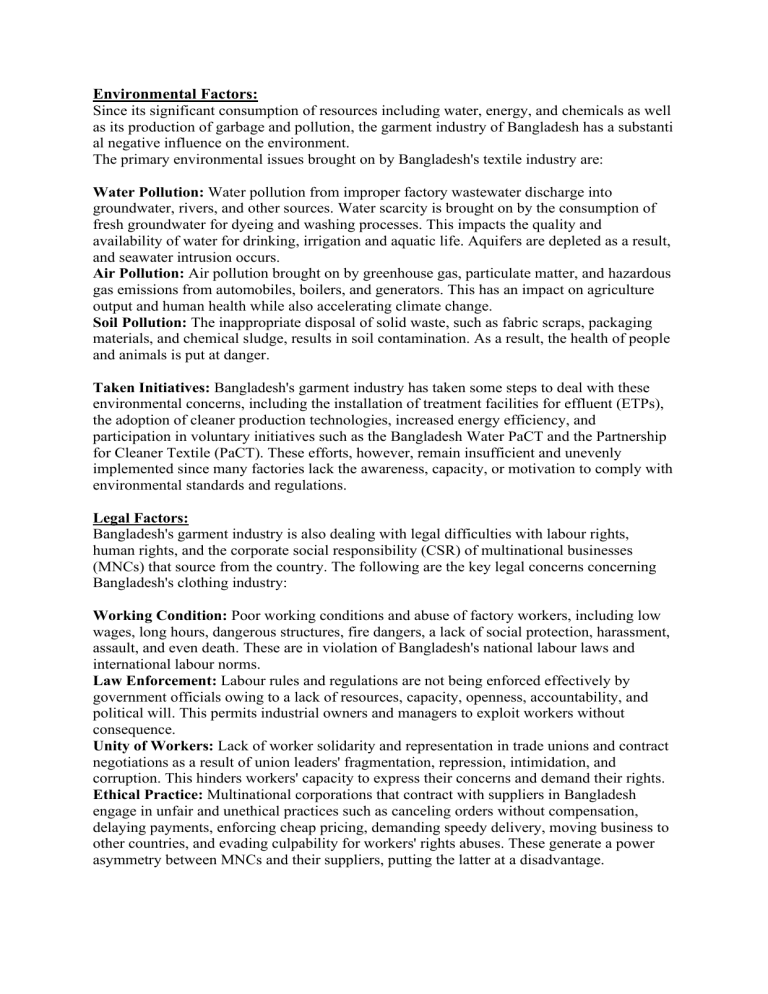
Environmental Factors: Since its significant consumption of resources including water, energy, and chemicals as well as its production of garbage and pollution, the garment industry of Bangladesh has a substanti al negative influence on the environment. The primary environmental issues brought on by Bangladesh's textile industry are: Water Pollution: Water pollution from improper factory wastewater discharge into groundwater, rivers, and other sources. Water scarcity is brought on by the consumption of fresh groundwater for dyeing and washing processes. This impacts the quality and availability of water for drinking, irrigation and aquatic life. Aquifers are depleted as a result, and seawater intrusion occurs. Air Pollution: Air pollution brought on by greenhouse gas, particulate matter, and hazardous gas emissions from automobiles, boilers, and generators. This has an impact on agriculture output and human health while also accelerating climate change. Soil Pollution: The inappropriate disposal of solid waste, such as fabric scraps, packaging materials, and chemical sludge, results in soil contamination. As a result, the health of people and animals is put at danger. Taken Initiatives: Bangladesh's garment industry has taken some steps to deal with these environmental concerns, including the installation of treatment facilities for effluent (ETPs), the adoption of cleaner production technologies, increased energy efficiency, and participation in voluntary initiatives such as the Bangladesh Water PaCT and the Partnership for Cleaner Textile (PaCT). These efforts, however, remain insufficient and unevenly implemented since many factories lack the awareness, capacity, or motivation to comply with environmental standards and regulations. Legal Factors: Bangladesh's garment industry is also dealing with legal difficulties with labour rights, human rights, and the corporate social responsibility (CSR) of multinational businesses (MNCs) that source from the country. The following are the key legal concerns concerning Bangladesh's clothing industry: Working Condition: Poor working conditions and abuse of factory workers, including low wages, long hours, dangerous structures, fire dangers, a lack of social protection, harassment, assault, and even death. These are in violation of Bangladesh's national labour laws and international labour norms. Law Enforcement: Labour rules and regulations are not being enforced effectively by government officials owing to a lack of resources, capacity, openness, accountability, and political will. This permits industrial owners and managers to exploit workers without consequence. Unity of Workers: Lack of worker solidarity and representation in trade unions and contract negotiations as a result of union leaders' fragmentation, repression, intimidation, and corruption. This hinders workers' capacity to express their concerns and demand their rights. Ethical Practice: Multinational corporations that contract with suppliers in Bangladesh engage in unfair and unethical practices such as canceling orders without compensation, delaying payments, enforcing cheap pricing, demanding speedy delivery, moving business to other countries, and evading culpability for workers' rights abuses. These generate a power asymmetry between MNCs and their suppliers, putting the latter at a disadvantage. Corporate Responsibility: The absence of strong CSR systems and frameworks that hold MNCs accountable for their sourcing from Bangladesh, such as reporting on non-financial aspects, checking for risks, resolving complaints, compensating for harms, and enforcing legal obligations. These enable the MNCs to avoid responsibility for their effects on the environment and society in their supply chains. Taken Initiatives: Some actions have been taken by the garment industry in Bangladesh to deal with these legal issues, such as joining multi-party initiatives like the Accord on Fire and Building Safety in Bangladesh and the Alliance for Bangladesh Worker Safety, enhancing adherence to labor laws and standards through checks and reviews, raising minimum wages for workers through regular adjustments, and participating in discussion and bargaining with trade unions and workers’ representatives. However, these efforts are also inadequate and inconsistently applied. As many MNCs do not have the commitment or willingness to respect and protect human rights and labor rights in their supply chains. References: • Sakib, S. N. (2023c, January 25). Garment industry in Bangladesh struggles to contain pollution. Eco-Business. https://www.eco-business.com/news/garment-industry-inbangladesh-struggles-to-contain-pollution/ • What’s next for Bangladesh’s garment industry, after a decade of growth? (2021, March 25). McKinsey & Company. https://www.mckinsey.com/industries/retail/ourinsights/whats-next-for-bangladeshs-garment-industry-after-a-decade-of-growth • Reza, N., & Du Plessis, J. J. (2022). The Garment Industry in Bangladesh, Corporate Social Responsibility of Multinational Corporations, and The Impact of COVID-19. Asian Journal of Law and Society, 9(2), 255–285. https://doi.org/10.1017/als.2022.9

